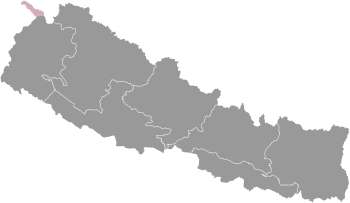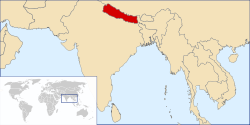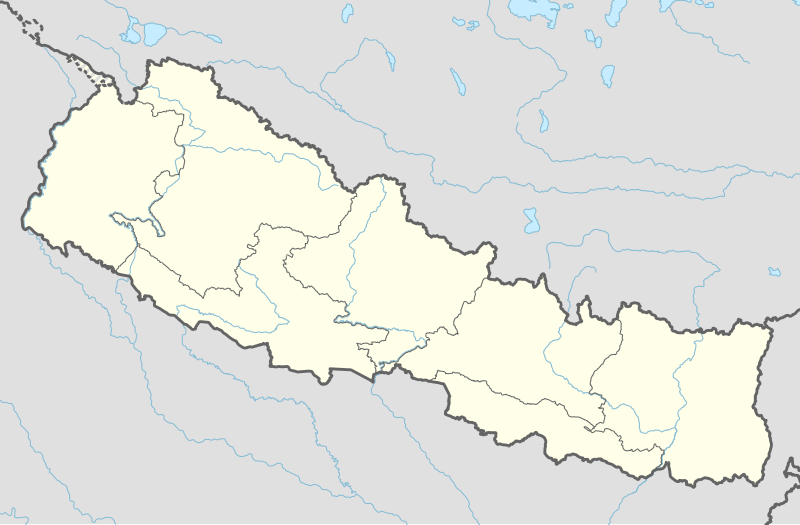Provinces of Nepal
| Provinces of Nepal नेपालका प्रदेशहरू Nepal ka Pradesh haru | |
|---|---|
 | |
| Category | Federated state |
| Location | Federal Democratic Republic of Nepal |
| Created |
|
| Number | 7 |
| Populations | Smallest: Karnali, 1,570,418 Largest: Bagmati, 5,529,452 |
| Areas | Smallest: Province No. 2, 9,661 square kilometres (3,730 sq mi) Largest: Karnali, 27,984 square kilometres (10,805 sq mi) |
| Government | |
| Subdivisions | |
| This article is part of a series on |
| Administrative divisions of Nepal |
|---|
 |
| Federal Democratic Republic of Nepal (since 2015) |
|
Nepal Portal Administrative divisions by country |
Politics of Nepal |
|---|
 |
|
The Provinces of Nepal (Nepali: नेपालका प्रदेशहरू; Nepālkā Pradeśharū) were formed on 20 September 2015 in accordance with Schedule 4 of the Constitution of Nepal. The seven provinces were formed by grouping the existing districts. The current system of seven provinces replaced an earlier system where Nepal was divided into 14 administrative zones which were grouped into five development regions.
History[]
A committee was formed to restructure administrative divisions of Nepal on 23 December 1956 and in two weeks, a report was submitted to the government. In accordance with the Nepalko Jilla Prashasan Punargathanko Report, 2013 (Nepali: नेपालको जिल्ला प्रशासन पुनर्गठनको रिपोर्ट, २०१३, romanized: A report on reconstruction of districts of Nepal, 1956), the country was first divided into total 7 Kshetras (area).[1]
- Arun Kshetra
- Janakpur Kshetra
- Kathmandu Kshetra
- Gandak Kshetra
- Kapilavastu Kshetra
- Karnali Kshetra
- Mahakali Kshetra
In 1962, all Kshetras were dissolved and the country was restructured into 75 development districts; those districts were further grouped into 14 zones.[2] In 1972, all 14 zones were grouped into 4 development regions; later in 1981, they were rearranged into the following 5 development regions.
- Eastern Development Region
- Central Development Region
- Western Development Region
- Mid-Western Development Region
- Far-Western Development Region
The provinces of Nepal were formed according to Schedule 4 of the Constitution of Nepal. The seven provinces were formed by grouping the existing districts; two districts, namely Nawalparasi and Rukum, were split between two provinces. Each district has local units. Local level bodies in Nepal include six metropolises, 11 sub-metropolises, 276 municipal councils and 460 village councils.[3] The current system of seven provinces replaced an earlier system where Nepal was divided into 14 administrative zones which were grouped into five development regions.
In January 2016 the Government of Nepal announced temporary headquarters of the seven provinces.[4] According to Article 295 (2), the permanent names of the provinces will be determined by a two-thirds vote of the respective province's legislature.
Government[]
The executive power of the provinces, pursuant to the constitution and laws, is vested in the council of ministers of the province. The executive power of the province shall be exercised by the province head (governor) in case of absence of the province executive in a state of emergency or enforcement of the federal rule. Every province has a ceremonial head as the representative of the federal government. The President appoints a governor for every province. The governor exercises the rights and duties as to be performed specified in the constitution or laws. The governor appoints the leader of the parliamentary party with the majority in the provincial assembly as the chief minister and the council of ministers are formed under the chairpersonship of the chief minister.
Assemblies[]
The Pradesh Sabha is the unicameral legislative assembly of each of the seven federal provinces.[5] The term for the members of the provincial assemblies is five years, except when dissolved earlier.
Candidates for each constituency are chosen by the political parties or stand as independents. Each constituency elects one member under the first past the post system of election. Since Nepal uses a parallel voting system, voters cast another ballot to elect members through the party-list proportional representation. The current constitution specifies that sixty percent of the members should be elected from the first past the post system and forty percent through the party-list proportional representation system. Women should account for one-third of total members elected from each party and if one-third percentage are not elected, the party that fails to ensure so shall have to elect one-third of total number as women through the party-list proportional representation.[6]
A party with an overall majority (more seats than all other parties combined) following an election forms the government. If a party has no outright majority, parties can seek to form coalitions.
List of Provinces of Nepal[]
| Emblem | Province | Capital | Governor | Chief Minister | Districts | Area (km2) |
Population (2011) |
Density (people/km2) |
Human Development Index (2019) | GDP per capita (US$) 2021 est. | Map |
|---|---|---|---|---|---|---|---|---|---|---|---|
| Province No. 1 | Biratnagar | Somnath Adhikari | Sher Dhan Rai | 14 | 25,905 km2 | 4,534,943 | 175 | 0.580 | 1,228 | 
| |
| Province No. 2 | Janakpur | Rajesh Jha | Mohammad Lalbabu Raut | 8 | 9,661 km2 | 5,404,145 | 550 | 0.510 | 882 | 
| |

|
Bagmati Province | Hetauda | Bishnu Prasad Prasain | Astalaxmi Shakya | 13 | 20,300 km2 | 5,529,452 | 272 | 0.661 | 2,440 | 
|
| Gandaki Province | Pokhara | Prithvi Man Singh Gurung | Krishna Chandra Nepali | 11 | 21,504 km2 | 2,403,757 | 108 | 0.618 | 1,300 | 
| |
| Lumbini Province | Deukhuri | Amik Sherchan | Kul Prasad KC | 12 | 22,288 km2 | 4,499,272 | 217 | 0.563 | 1,112 | 
| |
| Karnali Province | Birendranagar | Govinda Prasad Kalauni | Mahendra Bahadur Shahi | 10 | 27,984 km2 | 1,570,418 | 49 | 0.538 | 917 | 
| |

|
Sudurpashchim Province | Godawari | Ganga Prasad Yadav | Trilochan Bhatta | 9 | 19,915 km2 | 2,552,517 | 130 | 0.547 | 964 | 
|

|
Nepal | Kathmandu | President Bidhya Devi Bhandari |
Prime Minister Sher Bahadur Deuba |
77 | 147,557 km2 | 26,494,504 | 180 | 0.587 | 1,263 | 
|
See also[]
- List of districts in Nepal
- List of Nepalese provinces by population
- List of Nepalese provinces by GDP
- List of Nepalese provinces by HDI
- Administrative divisions of Nepal
 Nepal portal
Nepal portal
| Wikimedia Commons has media related to Provinces of Nepal. |
References[]
- ^ "नेपालको जिल्ला प्रशासन पुनर्गठनको रिपोर्ट, २०१३" (PDF) (in Nepali).
- ^ "Memorial Step of King Mahendra in 1st Poush 2017 BS". reviewnepal.com. 13 December 2017. Retrieved 6 February 2018.
- ^ Kathmandu Post (2017). "744 new local units come into effect". Kanntipur Publications Pvt. Ltd.
- ^ "Govt fixes temporary state HQs, guvs". Kathmandu: Kathmandu Post. 2018.
- ^ "CA approves ceremonial prez, bicameral legislature". Kanptipur Media Group. 16 September 2015. Retrieved 8 December 2017.
Provincial parliaments will be unicameral. "The CA also approved a mixed electoral system for parliamentary election with 60 percent directly elected and 40 percent proportionally elected."
- ^ "NEPAL: Diluted proportional electoral system". scoop.co.nz. Scoop world. 16 October 2017. Retrieved 8 December 2017.
- Provinces of Nepal
- Subdivisions of Nepal
- 2015 establishments in Nepal

